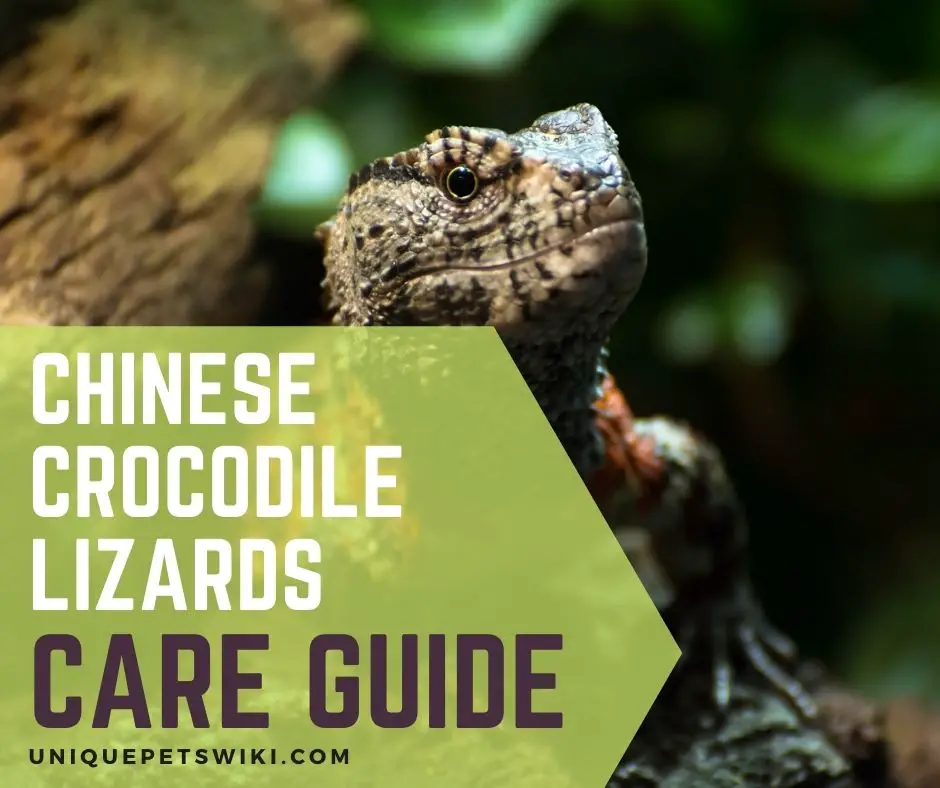If you’re considering keeping a Chinese crocodile lizard as a pet, then reading about how to care for them is one of the first things to do before acquiring the lizard.
As of now, the Chinese crocodile lizards are still least researched. Although they are among the most popular pets, they’re not as common as bearded dragons, leopard geckos, blue tongue skinks, and many others.
This makes information on them scanty. Because of this, most first-time keepers make mistakes in their husbandry because they couldn’t access credible information regarding its care.
As you’ll find out in this article, caring for pet Chinese crocodile lizards isn’t similar to that of other species of lizards. As their habitat is different, so is their temperature and cage set up.
Every aspect of its natural environment must be reflected in captivity and strictly adhered to.
For this purpose, this article, ‘The Ultimate Chinese Crocodile Lizard Care Guide For Beginners’ contains detailed information on their natural environment. We also talk about caring for them in captivity starting from their cost, cage set up, feeding, where to buy, temperature requirements, health checklists, and many more.
To access all the information in this article and fully understand these lizards, you must read this to the end.
Contents
What Are Chinese Crocodile Lizards?
If you fail to add the word ‘lizard’ to the crocodile, you might be referring to some species of crocodile that is native to China.
They’re reptiles, which means they have lungs with which they breathe while on land. But this species of lizards can also survive in water only for a short time. In their native region, they’re found in tropical forests near slow-moving streams and freshwater ponds.
Chinese Crocodile Lizard Appearance And Origin
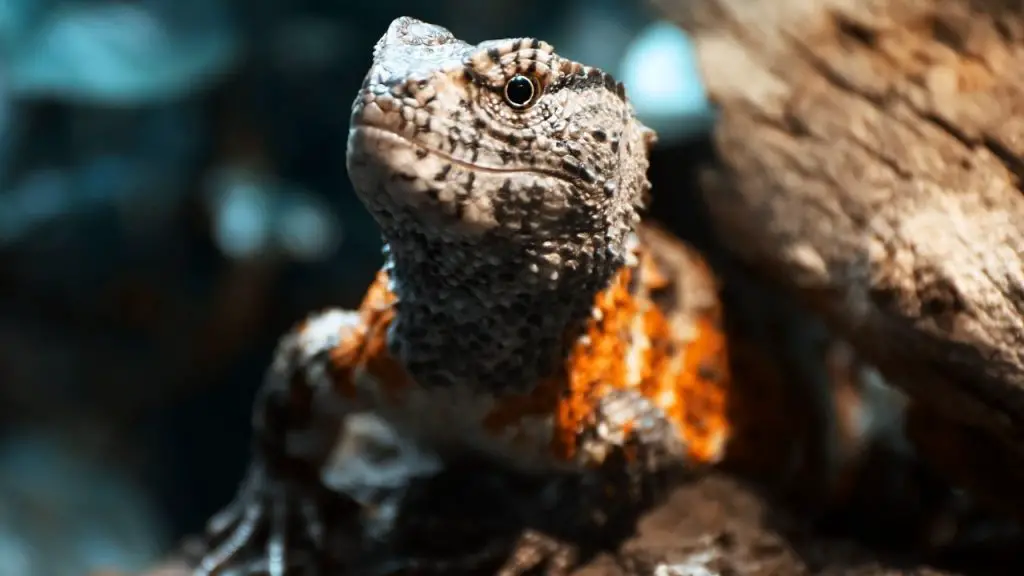
The Chinese crocodile lizard is a fascinating lizard that is native only to China and Vietnam. Specifically, the Hunan, Guangxi, and Guizhou provinces of southern China and the Quang Ninh province of Vietnam.
In each of these regions, they’re only found in cool forests near slow-moving streams and freshwater ponds.
Going by appearance, they make one of the most beautiful reptile lizards with their unique colors. This explains why reptile enthusiasts so desire them as pets.
They are brown in color with varying pattern colors, including yellow, red, white, grey, and black. The scales on their heads are plated with ridged scales behind the eyes.
As they age, their pattern colors tend to gradually turn to light and dark bands that extend to the tip of their tails.
Hatchlings of these lizards are deep brown with a lighter-tan head.
One distinctive feature of these lizards is the rows of enlarged, strong scales that run across its back down to the tip of its tail. These two rows of scales make them look like crocodiles, which is why they’re called crocodile lizards.
Chinese Crocodile Lizard Gender Differences And Mating
The Chinese crocodile lizards are sexually dimorphic. This means that the males and females of this lizard aren’t physically the same.
In this case, the males are more colorful than the females, with vibrancy in color becoming more prominent during breeding. Male crocodile lizards are also larger than females.
Why Do Chinese Crocodile Lizards Make Good Pets?

For many reasons, the Chinese crocodile lizards make good pets for all categories of herpetologists. Not only are they colorful but docile and friendly. They bond easily in captivity. They also have moderately easy care requirements.
19 Fun Facts About Chinese Crocodile Lizard
- Animals that can survive both in water and on land are called amphibians. The Chinese crocodile lizards aren’t amphibians but can survive in water and live on land. Although they can survive in water without any special adaptation features, their main habitat is land.
- Chinese crocodile lizards are large lizards that can get to 16-18 inches long and weigh up to 10 ounces. The males are even larger than the females.
- The Chinese crocodile lizards are sexually dimorphic. This means that the males are not just larger than the females but are also the most colorful.
- The Chinese crocodile lizards have gray-brownish backs with creamy-yellow bellies.
- The throat down to the lateral sides of the male’s bodies are covered with orange-red patterns. These patterns become more prominent in color during the breeding season.
- This species of lizard has two strong rows of bony and enlarged scales with sharp ridges on the tail. This feature is similar to that of crocodiles, which is why they’re called crocodile lizards.
- Although the Chinese crocodile lizard is terrestrial, it spends part of its life in the water. This feature makes it semi-aquatic. They have a strong muscular tail that facilitates swimming.
- Being semi-aquatic, the Chinese crocodile lizards cannot spend more than 30 minutes underwater before it resurfaces on land to breathe.
- The Chinese crocodile lizards are diurnal animals.
- This species of lizards are known to undergo a metabolic pause from time to time. A situation, they appear motionless and would usually feel nothing for hours. During this condition, they would slow down metabolism to conserve energy.
- Because of their frequent long hours of metabolic pause, they’re referred to as ‘the lizard of great sleepiness’. This name was given to them by the native people.
- The Chinese crocodile lizards are solitary animals, but they tend to stay together in groups during brumation in the wild.
- They hibernate when the water temperature drops to 15.5 C or below. This is usually between November and March.
- Like with other reptiles, a few months after brumation, the Chinese crocodile lizards are ready to mate. Mating for them usually lasts from July-August.
- When it comes to reproduction, the Chinese crocodile lizards are similar to humans. They are viviparous. That said, they give birth to live babies after a-nine month pregnancy period.
- In a single birth, female Chinese crocodile lizards can give birth to multiple babies ranging from 2-12.
- There’s no parental care among these lizards because at the moment of birth, the hatchlings can swim and fend for themselves.
- Their lifespan in captivity isn’t known. But with great care, crocodile lizards can live up to 10 years as pets or more.
Chinese Crocodile Lizard Costs
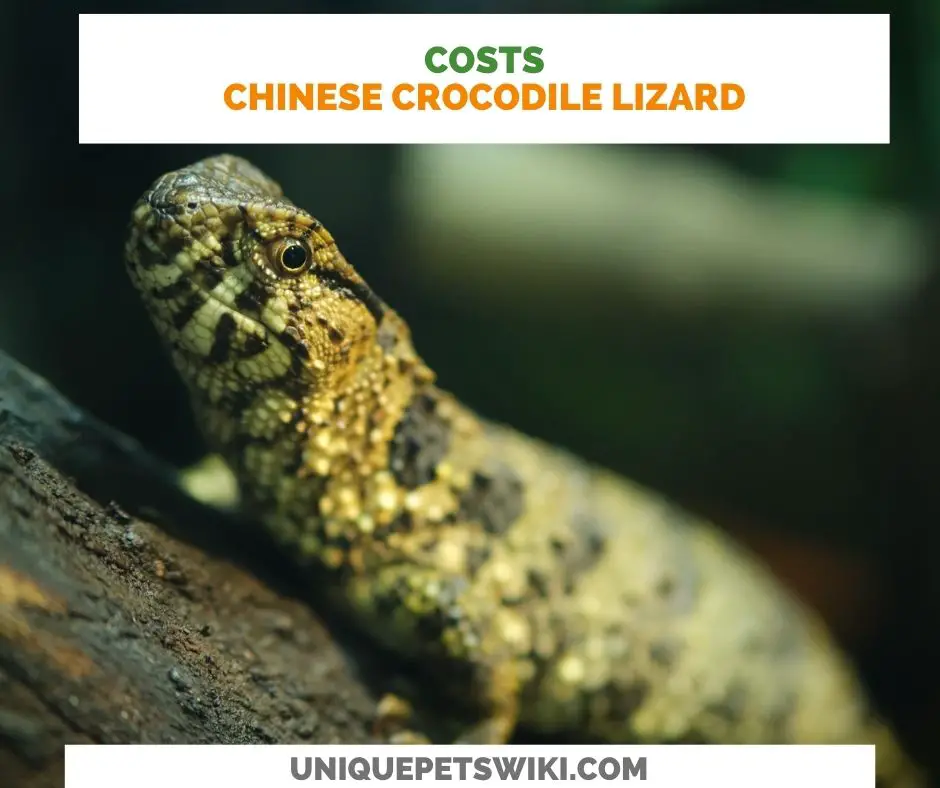
Keeping a Chinese crocodile lizard as a pet isn’t a regular walk in the park as with other reptiles species. The initial set up of its habitat will cost you some hundreds of dollars if you must give it a habitat that simulates the wild.
In all, you’d be spending about 2000 USD on housing a Chinese crocodile lizard as a first-time keeper.
How Much Do Chinese Crocodile Lizards Cost?
The Chinese crocodile lizards, as described, are one of the most stunningly looking pet lizards. They’re quite docile and easy to care for in captivity.
Because of their unique personality and the fact that they’re rare to find, they top the list of the most popular exotic pets. These lizards are sold for as high as 1,199.95 USD.
Where Can I Buy A Chinese Crocodile Lizard?
Exotic pets can be purchased from different vendors and outlets, but not all these places are good to buy Chinese crocodile lizards from.
Some of the online-based outlets can fabricate photos of the lizard, making it look more appealing than it is.
For you to enjoy your pet lizard after purchase, you should buy it from experts with credibility in selling this species of lizards or other exotic pets.
You would always come across various dealers with enticing price tags on their lizards. How to know which outlet or dealer to buy from is why this article is written.
That said, let’s look at some of them.
Pet Stores
Pet stores by far are one of the best places you can buy healthy lizards from.
For one reason, you’ll have the ease of mind that you bought from a credible outlet with reliable information about the pet you bought. Also including its care requirements and cage set up.
However, some of the pet stores aren’t living up to this expectation. They go too far in giving misleading information about the lizards just because they want to make sales.
In most cases, this misinformation often comes from an attendant who isn’t a herpetologist or at least knowledgeable about pet reptiles.
For this reason, you should make the necessary findings about the vendor you want to buy from before making the purchase.
Breeders
Buying directly from breeders is another best place to purchase your Chinese crocodile lizards.
You’ll have the opportunity to interact with the breeder to know the lizard’s feeding habits and health condition. Including the temperatures at which the lizard was kept.
Depending on the size, you’ll also get to know the gender and age of the lizard. To avoid being lied to, ensure you buy from a trusted and reliable breeder.
Avoid buying from online breeders except you know them personally.
Classified Ads And Facebook Groups
Two places I’ll never recommend you buy from are classified ads and Facebook groups. These are where new keepers often get diseased lizards.
Anybody can create an ad or a Facebook group claiming to sell these lizards without him being licensed to.
Moreover, most of the photos of the lizards you’ll see on these two platforms are fabricated photos.
Except it is a Facebook handle of a registered and licensed breeder, DO NOT BUY FROM CLASSIFIED ADS AND FACEBOOK GROUPS.
Reptile Rescues
Reptile rescues are fair enough to buy pet lizards from. The price you would get it here will be a bit cheaper than pet stores.
But keep in mind that some of the lizards there are either wild-caught species, lost one or two parts of the body, physically vulnerable, or have a history of poor husbandry.
Thus, you should know beforehand what you’re in for. That notwithstanding, you’ll still get completely healthy lizards here.
Chinese Crocodile Lizard Cage Set Up Cost
Much work is into setting up your lizard’s habitat as it is in buying every accessory you need. You’ll need more branches and cork backs to make up its terrestrial area.
To avoid contaminating the habitat, none of its cage accessories should be locally sourced. With this in mind, buying every accessory from a reputable pet store will cost you between 700-1000 USD.
Home Set Up For Chinese Crocodile Lizard
Chinese crocodile lizards don’t move a lot, but they need a big enclosure since they’re semi-aquatic.
If you choose to house two or more of the lizards together or during breeding, then you should get an enclosure size of 4.9 x 1.6 x 1.9 feet.
More heights can be added to the tank as these lizards are excellent climbers. Since they love climbing, they’ll make good use of every piece of cork, branches, and other decorations they have, especially branches placed above the water area.
Hides
Many things can be used as hides in their enclosure. These include cork back, plants (to provide shades), and some crevices in the branches that’ll be added for climbing purposes.
Since they’re semi-aquatic, they’re not known to be burrowers in the wild. If they are threatened in the wild, they usually drop to the nearby pond or stream as a way of escape.
Thus, you should provide them a water area deep enough to cover their whole body but shallow enough to let them bring their head out easily.
Substrates
There are two ways to set up the habitat for Chinese crocodile lizards. Depending on which way you want to set up their habitat, you may not need substrates.
You can choose to fill the entire floor space of the tank with water up to 2 inches and clutter it up with different sizes of branches, cork backs, and plant pots.
If you choose this method, what you’ll need as substrates will only be some small stones, white sand, and some tiny fishes. Although fish is optional, it’ll give their habitat a natural look.
Alternatively, you can divide the enclosure into two sections. One side to be dry land and the other section is simulating a pond or slow-moving stream.
To do this, you’ll have to place a plastic basin containing water up to 2-2.5 inches deep on one side of the enclosure.
The section cut out for the pond should be about one third (1/3) of the entire floor space. Inside the water, you can add some stones, sand, and some tiny fishes.
You can use garden soil with mosses or a mixture of washed play sand and clay as substrates on the remaining space.
Securely place various sizes of branches, rocks, barks (for hiding), and a balanced branch hung across the pond for basking. Whichever cage set up you choose, have in mind that cleaning up wouldn’t be easy.
Watch here for a clearer understanding of how to set up their habitat.
Water
You’ll need fresh water to set up the pond area in their habitat. Ensure that the water is filtered using an effective filter. To keep the water fresh and free from bacteria, you’ll need to change it at least once in six months.
Heating And Lighting
Being semi-aquatic, the Chinese crocodile lizards can thrive in a low-temperature habitat. In the wild, the ambient temperature of their habitat can drop to as low as 15° F. This is usually the period they undergo brumation.
Thus, in captivity, you can mimic their natural environment by maintaining an ambient temperature of 68° F with a basking spot temperature of 95 F. Although these lizards can thrive without UVB, it is still important to add a UVB bulb in their enclosure.
Humidity
Another important factor in their cage set up is the humidity of the tank. Always keep in mind that their habitat is filled with water already. Hence, over-humidifying the enclosure may cause some skin problems.
The tank should be set up in such a way that the lizards would be able to dry up completely if not in the pond (water).
Cost Of Feeding Chinese Crocodile Lizard (Spend On Food)
In the wild, the Chinese crocodile lizards feed primarily on invertebrates. Since they’re semi-aquatic, they can eat both insects, ants, and freshwater animals such as snails, worms, tadpoles, and larvae.
In captivity, because of availability, they’re often fed insects, crickets, snails, different types of worms such as mealworms, superworms, waxworms, and calciworms.
You can find all of these feeders from local pet stores. At individual pet stores, 25-100 counts of large worms are sold between 2.99-4.99 USD respectively. 500 counts of crickets are sold for 18.99 USD, while a can of 25 unshelled snails is sold for 5.75 USD.
In total, you would be spending about 28-30 USD on feeding every few weeks or a month.
Cost Of Cohabitation
In the wild, the Chinese crocodile lizards do not stay in groups. A lizard is believed to occupy a pond (territory) all by itself. However, during brumation and breeding season, they tend to cohabit.
In captivity, if you intend to keep two or more Chinese crocodile lizards together, ensure you get a big enclosure that can accommodate them conveniently.
This way, you’ll not incur additional charges other than feeding. But the ideal thing is to keep each individual lizard separately in separate enclosures. You should only pair them off during breeding.
To keep two to three Chinese crocodile lizards in separate enclosures will cost you double the amount for keeping one. However, if you keep them together, you’ll only spend more on feeding. This will cost you 30 USD every one-two months.
Medical Cost For Chinese Crocodile Lizard
If your lizard should have any need to visit the vet, you should expect to spend 500-1000 USD or more on veterinary bills. But they’re hardy lizards that don’t get sick easily.
Hence, if your habitat and husbandry is appropriate, you may not need to visit a vet in a long while.
How Do I Choose The Right Species Of Chinese Crocodile Lizard?
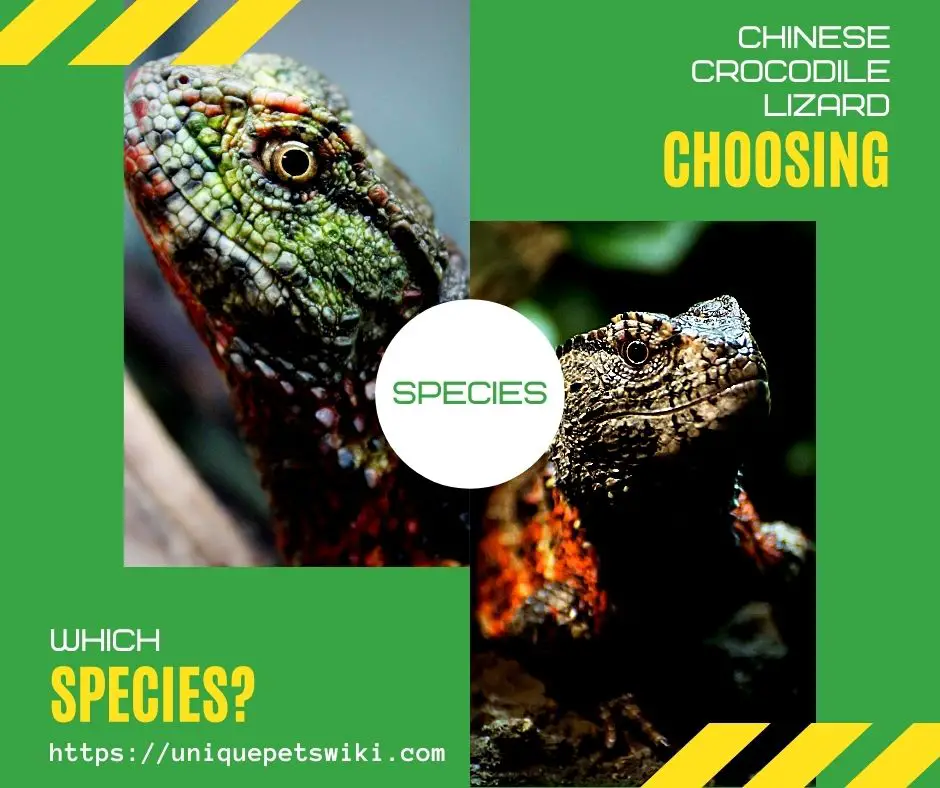
So far, Shinisaurus crocodilurus crocodilurus Ahl which is found in Southeastern China, and ‘Shinisaurus crocodilurus vietnamensis which is found in Northeastern Vietnam are the only two known subspecies of Chinese crocodile lizards.
The subspecies native to china was found in 1930 while the other species native to Vietnam was found in 2016.
Both subspecies are similar in every aspect with no difference in care requirements, diet, and temperaments. The only difference between them is their country of origin.
Thus, both subspecies make good pets. That said, whichever subspecies appeal to you is a good start.
Chinese Crocodile Lizard Health Checklist
As stated earlier, Chinese crocodile lizards aren’t known to frequently have health issues like other lizards. But you should always keep an eye on your lizards for bacterial/fungal infections.
Bacterial and fungal infections such as respiratory infection and skin infections are the most common Chinese crocodile lizards’ health issues. Aside from these two diseases, other health issues, and what to check for include:
- Stress: This can be as a result of a poor cage set up or moving the lizard to a new cage.
- Diarrhea.
- Respiratory infection.
- Metabolic Bone Disease.
- Retained Shed.
- Skin Infections.
How To Have Fun With Your Pet Chinese Crocodile Lizard (Toys And Games)
Having fun with your pet, Chinese crocodile lizards is a matter of creativity. These lizards love to swim in water. Hence, taking them for an outdoor bath in a shallow pool under the sun would be fun.
First, get a shallow tube and fill it up with at most 2 feet of water. Leave the water for some time to get warm to about 68° F before you bring in your lizard.
You can add one or two floaties in the water where your lizard can climb on to bask if it desires.
Other than outdoor baths, you can see a movie or watch your favorite TV programs with your lizard.
Another way of having fun with your lizard is letting it climb on you. Chinese crocodile lizards are excellent climbers. Hence, when they bond with you very well they would want to climb on you each time they have the opportunity to.
With this in mind, occasionally bring out your lizard from the cage to have fun climbing on you.
All creatures love cuddling, including your Chinese crocodile lizard. After each outdoor bath, you can let your lizard snuggle in your bed before returning it to its cage.
Aside from this, you can make some of its mealtime fun. This means you’ll have to feed your lizard in a separate tank where you can put some of its food in a box filled with paper towels, small hides, or foliage balls.
This way, your lizard will keep itself busy searching for the worms in the box.
Chinese Crocodile Lizard Care Guide
This section seeks to give information on how to care for your pet Chinese crocodile lizards the best way. This include:
- What to feed and what not to feed.
- How to feed and how often to feed
- How and when to clean its cage
- How to handle and bond with your lizard.
- How to bathe and have fun with your lizard.
- How and when to brumate.
- Diseases and sicknesses to check for and how to prevent them.
- That said, let’s look at each of these care requirements in detail.
Diet – What Should I Feed My Chinese Crocodile Lizard?
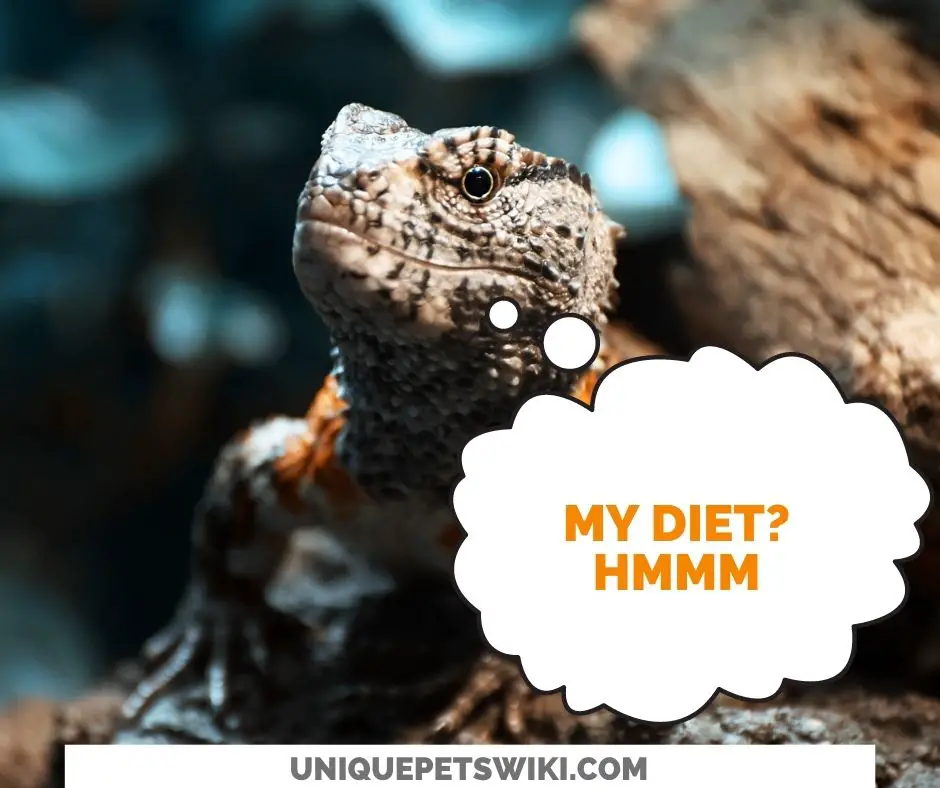
As earlier stated, Chinese crocodile lizards can be fed any type of insect given to other reptiles. This includes crickets, cockroaches, grasshoppers, butterworms, wax moth larvae, silkworms, calciworms, earthworms, and all other types of worms.
Being semi-aquatic, their diet should also include fish, crabs, snails, tadpoles, shrimps, and lobsters. Besides giving lobsters, fish, and other freshwater foods to your lizards, those foods can be added to the pond area of their enclosure.
Some breeders after interacting with them on how they care for their Chinese crocodile lizards mentioned that they have success feeding fuzzy or pinky mice once in a while to them.
You can as well try it with your lizards. But if your lizard seems not to enjoy it then stop offering it.
Daily Feeding And Cleaning Routine
Chinese crocodile lizards can be fed in three ways: –
- Hanging a feeding trough/dish containing its food on a branch. The dispensed feeding dish should drop to the level the lizard can conveniently eat from underwater or on another branch.
- Giving the food to your lizard yourself using a tong or forceps.
- Feeding the lizard in a separate box outside its tank.
Feeding your lizard in a separate box outside its cage isn’t entirely the best way because of stress. If you have to move your pet every day you want to feed it to a different box, your lizard will end up being stressed out.
Although this method ensures easy cleaning, in the long run, your lizard will develop some health problems as a result of stress. This may include loss of appetite.
On the contrary, the first two approaches to feeding mentioned above are ideal. The only thing you’ll be required to do is to clean out any food particles that dropped while feeding.
Hatchlings and younger ones should be fed every day. In contrast, adults should be fed 4-5 or 6 days a week. The older the lizard gets, the lesser it eats.
The number of feeder insects for each meal will differ with age. Younger Chinese crocodile lizards can be given 5-10 worms or only one snail per meal. However, adults will eat less quantity than that.
Note that giving your lizards a variety of foods from their wide range of diet is important to ensure balanced diets. Besides, it’ll help prevent your lizard from becoming a picky eater.
Handling And Bonding

Captive-bred Chinese crocodile lizards love to be handled. Even wild-caught species can be tamed with frequent handling. Handling your lizard frequently will ensure quick bonding.
While handling your lizard, ensure you provide enough support to it with your palm (hand).
Since these lizards can get to 16 inches in length, the best way to handle it is by letting its entire body (from the head down to the tail) rest on your hand. That is if you’re using only one hand.
You should always use two hands to provide maximum support.
Shedding
Chinese crocodile lizards don’t shed quite often. Shedding for these lizards takes some time. It can last for a few days. And they may need your help to shed off successfully.
In case they have difficulty shedding successfully, you can use Zoo Med shedding aid to ease the stuck shed.
Alternatively, you can soak the lizard in warm water and remove the retained shed yourself. But note that this requires some level of expertise. If you aren’t experienced in removing retained shed, seek the service of a vet.
Bathing

Their habitat is semi-aquatic already. Hence, frequent baths wouldn’t be necessary. Limit bathing to only when you want to bond with them or when they have issues shedding.
Always keep the temperature of their bathing water slightly above the water-temperature in their cage. To make bath time fun, include some floaties and other toys to play with. Also, make the water soapy but not in excess.
Brumation
In the wild, these lizards go through brumation between November and March. This is usually when the water temperature drops below 60° F, too cold for these lizards to bear.
Hence, to survive this period is why they brumate or hibernate. During this period, they would eat less, sleep more, and tend to stay in small groups.
Since this usually happens during winter (from November-March), this period should be observed as well in captivity.
Depending on when your winter season is, to indicate brumation time, gradually reduce the amount of daytime light and heat to 8, 6, and 5 hours daily respectively.
When this is initiated, reduce the amount of food given to once in two weeks. As more heat will not be provided during this time, less food should be given. Reptiles need heat to digest their food. Without it, the food will rot in their stomach.
Cleaning The Habitat
From time to time you’ll need to clean out poops and other debris from the water area of the terrarium. This will keep the water clean, fresh, and less offensive in smell.
To clean the terrarium, use a siphon vacuum aquarium cleaner or any other thing similar to this.
Also, clean the terrarium walls with a natural cleaning detergent that wouldn’t harm the lizards. If you have a tank with a dry end, check that the substrate is not messy (that is not too moist).
Chinese Crocodile Lizard Health: Diseases And Illnesses

In the wild, the major threats to these animals are deforestation and other human activities that made them lose their habitat. Being preyed on by other bigger animals is just secondary.
In captivity, they’re not known to get diseased often except in cases where husbandry is faulty. The most common diseases in captivity are skin infection, diarrhea, metabolic bone disease, respiratory infection, and other fungus causing infections.
What usually triggered fungus infection in captivity is cold water. During the winter season (brumation period), where the water is very cold, you should cover the water area of its cage with plastic to make the enclosure warmer.
Respiratory Infection
In the wild, these lizards sleep on plants or branches with their nose facing the direction of the wind. This way, they have a free flow of air and ideal air circulation.
However, this experience is reduced in captivity, which later leads to a respiratory disorder. To prevent this poor air circulation in captivity, use an aqua-terrarium with a screen on the opposite sides and a computer ventilator.
Metabolic Bone Disease (MBD)
This is a diet-related disease caused by a lack of calcium. Since Chinese crocodile lizards need low UVB, supplemental calcium with vitamin D3 should be added to their diet. This supplement should be dusted to the feeder insects while feeding them.
Diarrhea
Diarrhea is another possible health issue, but it’s not common. This can be as a result of infection or a sign of an allergy to either its food or some chemicals.
Always find out the underlying cause and treat it in time. To give your pet a better treatment, you may need to see a vet.
Conclusion
Like I said earlier, keeping a Chinese crocodile lizard for the first time isn’t going to be a regular walk in the park as with other pet lizards. It takes lots of effort.
You have to be psychologically and financially ready to handle the responsibilities that accompany it. But in the end, you’ll be glad you have these creatures around you.
